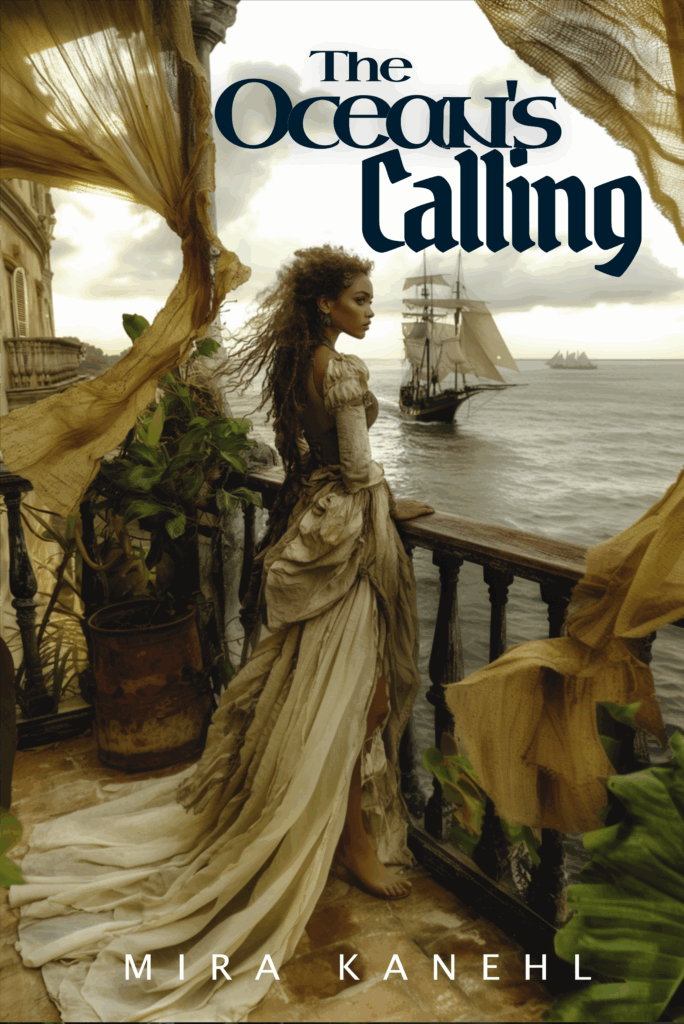One Virtue And A Thousand Crimes series
The historical fiction series One Virtue And A Thousand Crimes features the compelling Jean Laffite à la James bond, the fierce pirate Jezebel Medusa and local antagonists that meet in the sizzling historical context of the smaller Golden Age of Piracy. If you like a pirate merger of Sherlock Holmes and Outlander, then you’ll love Mira Kanehl’s page-turning series.
- One Virtue And A Thousand Crimes series
Unveil the intriguing past of New Orleans (1810-1830): A haven for pirate stories and swashbuckling adventures
Step back in time to the vibrant and mysterious New Orleans of 1810-1830, an era steeped in tales of pirates, smugglers, and extravagant masquerade balls. Explore the rich historical tapestry of this bustling port city, where the enchanting allure of pirate stories meets the lively traditions of Mardi Gras.

Want free historical content?
Jean Laffite, the enigmatic smuggler
Embark on a captivating journey through the muddy streets of New Orleans during the early 19th century as we delve into the mysterious world of Jean Laffite, a legendary figure whose exploits straddled the line between piracy and patriotism, and Cosma Drilo, a female pirate who crosses his plans. In the historical fiction odyssey of One Virtue And A Thousand Crimes, witness the vibrancy and chaos that defined the Crescent City from 1810 to 1830.
Laffite’s shadowy presence in the Crescent City adds an alluring layer to historical fiction about pirates, weaving tales of clandestine operations along the Gulf of Mexico, Barataria, and the small rivers all the way up to Donaldsonville. His charismatic and enigmatic figure emerges as a central character in our tales, set against the backdrop of political upheavals and societal transformations in post-colonial Louisiana. As a privateer, smuggler, and perhaps even a hero, Laffite’s actions echo the spirit of an era teetering on the edge of lawlessness.
Laffite’s efforts in the War of 1812
During the War of 1812, Jean Laffite was a privateer, fighting for the United States against the British. In 1814, the U.S. government issued a pardon for Laffite and his men, offering them amnesty if they agreed to help defend New Orleans. Laffite accepted the offer, but the pardon was later revoked. During the Battle of New Orleans in 1815, Laffite and his pirates played a controversial role. Although they fought on the side of the Americans against the British, their reputation as pirates led to a strained relationship with General Andrew Jackson. However, after the war, he returned to piracy and became a notorious figure in the Gulf of Mexico.
Barataria Bay
He operated out of Barataria Bay, a coastal area in Louisiana. He and his brother, Pierre, established a pirate colony there, which served as a base for their smuggling and privateering activities. There are theories that suggest Laffite had connections to Napoleon Bonaparte. Some believe that Laffite may have been involved in a plot to rescue Napoleon from exile on the island of Elba.
Laffite’s legacy
After the Battle of New Orleans, Jean Laffite’s activities become less documented. There are various theories about his fate, with some suggesting he continued his life of piracy, while others propose that he may have settled in Texas or Central America. Jean Laffite’s legacy is still present in popular culture. He is often romanticized as a swashbuckling pirate, and his story has been featured in numerous other books, but also in movies and songs. Jean Laffite remains a mysterious and intriguing character in history, with much of his life shrouded in legend and speculation.
Masque balls and Mardi Gras extravagance
New Orleans in the early 19th century was not just a hub for maritime activities, but also a city that knew how to celebrate. Masque balls, where attendees concealed their identities behind elaborate masks, provided a backdrop for secret rendezvous and clandestine affairs, and are also where Jean Laffite first meets the mysterious Cosma Drilo. The first recorded Bal Masqué in the city took place in 1813, and it continued to be a highlight of the social calendar for many years. The festive spirit of Mardi Gras, with its vibrant parades and celebrations, infused the city with an energy that echoes through the pages of the best pirate stories set in this era.
Society at masked balls
New Orleans was a melting pot of cultures, and masquerade balls provided a space where people from different backgrounds could come together and celebrate. The balls often featured a mix of French, Spanish, Creole, and African influences in both the music and dance. But they were not just about entertainment; they also played a role in reinforcing social hierarchies. The guest lists were carefully curated, and attending these events could signify one’s social status and standing in the community. The masked nature of these events added an element of mystery and romance. Attendees could engage in flirtation and courtship without revealing their true identities, creating an alluring and exciting social dynamic.
Creole influence on masked balls
Particularly creole society played a significant role in shaping the masquerade ball culture. Creole aristocracy, known for their sophisticated social events, frequently hosted and attended these balls, contributing to their opulence and elegance.
Costumes at masked balls
Masquerade balls were known for the elaborate and extravagant costumes worn by attendees. Masks were a crucial element, allowing participants to conceal their identity and engage in a playful sense of mystery and intrigue. The masks added an air of anonymity, enabling people to socialize freely.
Dances at masked balls
Quadrilles, cotillions, and other popular European dance styles were common at these events. However, the influence of African and Creole dance traditions could also be observed, creating a unique fusion of movement styles.
Themes at masked balls
Some masquerade balls had specific themes, contributing to the overall festive atmosphere. The venues were adorned with colorful decorations, flowers, and drapery to create a magical and enchanting ambiance.
Music at masked balls
Live music was a crucial element of masquerade balls. Musicians played a variety of instruments, including violins and pianos, providing a soundscape for the evening’s festivities. The music often included a mix of classical European compositions and local Creole tunes.
The period between 1810 and 1830 marked a particularly vibrant era for masquerade balls in New Orleans. However, as the 19th century progressed, the social and cultural landscape of the city evolved, and the traditions associated with masquerade balls underwent changes.
Cultural tapestry
The cultural mosaic of New Orleans during this time was a fascinating blend of French, Spanish, African, and Creole influences. This diversity added a unique flavor to the stories of pirates and adventurers navigating the intricate social landscape of the city.
Creole society
The term “Creole” in New Orleans referred to individuals of European descent born in the colony. Creole society had its own distinct customs, language, and social norms, creating a vibrant cultural scene that included music, dance, and cuisine.
Quadroon balls
These were social events held in the city where young women of mixed-race ancestry (usually of one-quarter African descent) were introduced to potential suitors from white Creole society. These events played a significant role in the complex social structure of the time.
Congo Square
Despite the restrictive laws of the time, Sundays in Congo Square became a gathering place for enslaved Africans and free people of color. It was a space where they could express their cultural heritage through music, dance, and rituals, contributing to the development of jazz and other musical genres.
Spanish influence
The early 19th century saw the transition of New Orleans from a French to a Spanish colony (1762-1803), and then back to French rule before being sold to the United States in the Louisiana Purchase. This mix of European influences left an indelible mark on the city’s architecture, language, and traditions.
Voodoo and spiritual practices
The practice of Voodoo, a syncretic religion with roots in African spiritual traditions, thrived in New Orleans during this period. Marie Laveau, a famous Voodoo priestess, became a prominent figure, and her legacy continues to influence the city’s mystique. Cosma meets her and her daughter Marie in The Ocean’s Calling.
Battle of New Orleans (1815)
The Battle of New Orleans, fought in 1815 as part of the War of 1812, had a profound impact on the city’s identity. The victory, led by General Andrew Jackson, solidified New Orleans as a symbol of resilience and contributed to a sense of local pride.
Literary culture
The early 19th century also saw the emergence of a literary culture in New Orleans. Writers like Lafcadio Hearn, known for his works on New Orleans and its folklore, began to capture the unique cultural elements of the city in their writings.
Economic prosperity
The period saw economic growth driven by the expansion of the cotton industry and the port of New Orleans. This prosperity influenced the city’s social and cultural life, attracting a diverse population seeking opportunities in trade and commerce.
Health challenges and epidemics
While the city thrived with culture and commerce, the inhabitants faced health challenges. Yellow fever and other diseases were rampant, casting a shadow over daily life and providing a grim backdrop for the dramatic narratives of historical fiction about pirates.
Yellow fever epidemics
New Orleans, with its warm and humid climate, was particularly susceptible to yellow fever outbreaks during this period. The disease is transmitted by mosquitoes, and the city’s geography and climate created favorable conditions for their proliferation. Yellow fever epidemics were devastating and had a significant impact on the population.
Sanitation issues
The lack of proper sanitation and waste disposal systems in the early 19th century contributed to the spread of other diseases, too. The city’s proximity to the Mississippi River increased the risk of waterborne illnesses, and inadequate waste management likely contributed to the prevalence of diseases such as dysentery and cholera.
Malaria
Another mosquito-borne disease, malaria, was likely a concern. The wetlands and marshy areas surrounding New Orleans provided breeding grounds for malaria-carrying mosquitoes.
Limited medical knowledge and resources
Medical knowledge and practices during this period were not as advanced as they are today. Limited understanding of germ theory, hygiene, and disease transmission hindered effective public health measures. Additionally, medical resources and facilities were not as developed as in later years.
Population density and living conditions
The population of New Orleans grew rapidly during this time, and living conditions in densely populated areas were often cramped and unsanitary. Overcrowded living spaces specifically facilitated the spread of infectious diseases.
Slavery and health disparities
The institution of slavery had a profound impact on health disparities. Enslaved individuals often faced poor living conditions, inadequate nutrition, and limited access to medical care, contributing to higher susceptibility to diseases.
Limited healthcare infrastructure
The city’s healthcare infrastructure was not as robust as it would become in later years. Limited access to medical professionals and healthcare facilities would have impacted the ability to prevent and treat illnesses effectively.
Government intrigues
In the melee of piracy and cultural diversity, the government of New Orleans played a crucial role. The shifting alliances, power struggles, and political intrigues add layers of complexity to the stories of pirates navigating both the treacherous waters of the Gulf and the intricate political landscape of the city. During the time frame of 1810 to 1830, New Orleans underwent significant political changes, transitioning from Spanish rule to American governance.
Spanish influence
Prior to the American acquisition, the city had been under Spanish rule for several decades. The Spanish government had left a lasting impact on the culture, architecture, and legal traditions of the region.
Louisiana purchase (1803)
In 1803, the United States acquired the territory of Louisiana, including New Orleans, from France in the famous Louisiana Purchase. This marked the beginning of American influence in the region. The transfer of New Orleans from Spanish to American control officially occurred in 1803. The Spanish flag was lowered, and the American flag was raised on December 20, 1803.
Territorial governance
Initially, New Orleans was governed as part of the Territory of Orleans, which was established in 1804. The territorial government was responsible for establishing local laws and regulations.
Growth and immigration
In the early 1800s, New Orleans experienced significant growth and an influx of immigrants, including Americans, Europeans, and free people of color. This diverse population contributed to the unique cultural tapestry of the city.
Ballte of New Orleans (1815)
One of the significant events in the early 1800s was the Battle of New Orleans in 1815, which took place after the War of 1812 had officially ended. The battle, led by General Andrew Jackson, resulted in a decisive American victory over the British and increased the city’s prominence.
Statehood
Louisiana was admitted to the Union as the 18th state on April 30, 1812. New Orleans became a key city within the new state, and its economic importance continued to grow.
Legal system
The legal system in New Orleans reflected a mix of French, Spanish, and American legal traditions. The Civil Code of 1808, influenced by the Napoleonic Code, had a lasting impact on Louisiana’s legal framework.
Municipal governance
The city operated under a city council system during this period. The government structure evolved over time as the population and needs of the city changed.
Cultural contributions
New Orleans was a melting pot of cultures, with influences from Europe, Africa, and the Caribbean. This cultural richness was reflected in the city’s music, cuisine, and social traditions, such as Mardi Gras.
The period from 1810 to 1830 marked a crucial time in the history of New Orleans as it transitioned from a multicultural colonialization to a vibrant American city with a unique blend of cultural influences. Immerse yourself in this captivating historical context where the vibrant culture, mysterious marshes, and political intrigues form the perfect backdrop for the best pirate stories and tales of adventure. Uncover the hidden gems of this era through the lens of historical fiction, where the spirit of Jean Laffite and the allure of the Crescent City come to life.
FAQs
What is One Virtue And A Thousand Crimes about?
One Virtue And A Thousand Crimes is a captivating historical fiction series that follows the daring adventures of a prostitute turning pirate. Set during the 18th century, the series blends thrilling action with rich historical details, focusing on themes of rebellion, freedom, and survival in a male-dominated world. The lead character defies societal norms while facing both external battles and internal conflicts.
Where does the title One Virtue And A Thousand Crimes come from?
The title One Virtue And A Thousand Crimes comes from a line in Lord George Gordon Byron’s poem The Corsair, which so aptly described Jean Laffite back then that people believed the poem was about Laffite (which it was not) and the general character of pirates.
Who is the main character in One Virtue And A Thousand Crimes?
The main character in One Virtue And A Thousand Crimes is a fierce and courageous female pirate who defies the traditional roles assigned to women in the 18th century. Her journey highlights themes of independence, resilience, and leadership as she fights for her place in a dangerous and unpredictable world.
Is One Virtue And A Thousand Crimes historically accurate?
While One Virtue And A Thousand Crimes is a work of fiction, it draws heavily from real historical events, the pirate culture of the 18th century, Jean and Pierre Laffite, and New Orleans. Mira Kanehl weaves historically accurate details into the narrative to provide an immersive experience, but some creative liberties are taken to enhance the story’s drama and character development, e.g. Cosma Drilo didn’t actually exist, and Walker Gilbert was only customs inspector in Donaldsonville, not an amateur detective.
What makes One Virtue And A Thousand Crimes stand out from other pirate books?
One Virtue And A Thousand Crimes stands out because of its unique female (LGTB+) lead and focus on her personal evolution amid a turbulent historical backdrop. Unlike many pirate stories that center on male characters, this series explores a woman’s fight for autonomy and respect in a dangerous, male-dominated world, making it both empowering and engaging.
Is One Virtue And A Thousand Crimes suitable for all readers?
No. One Virtue And A Thousand Crimes is ideal for readers who enjoy historical fiction with strong female protagonists, action-packed adventure, and deep character development. However, due to its mature themes, such as sex, violence and the harsh realities of pirate life, it is only suited for an adult audience who can deal with trigger moments.
Like what you’re reading? Share it!
This is going to be incredibly useful for my work.
Thank you Blogi Nauki, I appreciate it! 🙂
Reading this piece felt like walking through a beautiful garden of ideas — each thought more inviting than the last.
Thanks TyT! I appreciate it! 🙂
Very insightful read—definitely bookmarking this site for future reference.



Leave a Reply